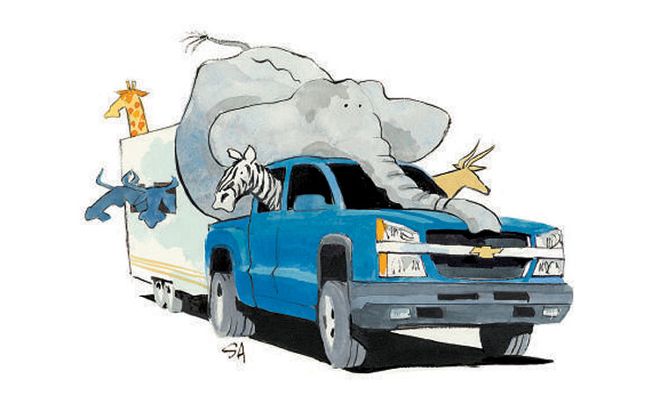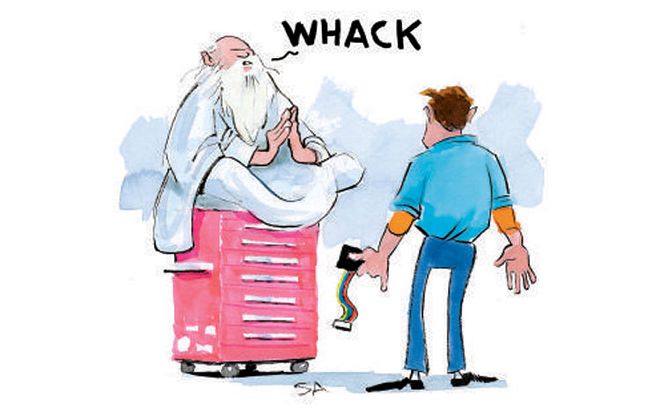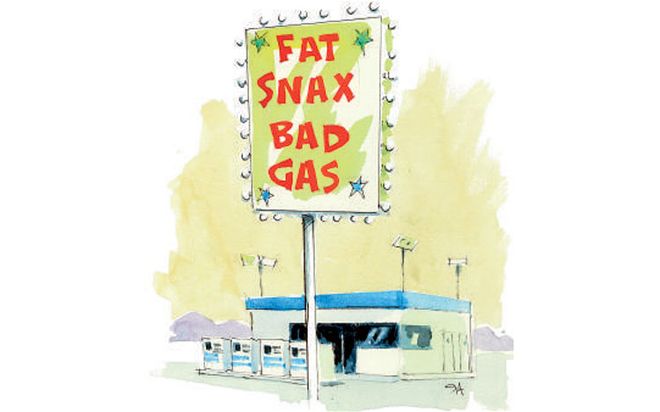
| safe Towing illustration
SAFE TOWINGQ: I own a 2004 Chevy Silverado 2500HD with the 6.0-liter V-8 engine and the factory towing package. I plan to buy a fifth-wheel RV, which weighs 12,300 pounds. Chevrolet's literature lists maximum fifth-wheel towing capacity as 10,100 pounds, yet the same truck with a diesel engine can tow a 16,100-pound fifth-wheel trailer. Is it safe for me to tow this fifth-wheel trailer with my truck? I understand the diesel has much more torque, which makes for easier towing. My Chevrolet dealer's chief mechanic said as long as I drive it sensibly, and it's a fifth-wheel trailer, it should be fine. Also, from a structural point of view (axle load, wheels, and tires), am I endangering anything by towing the heavier-than-approved fifth-wheel trailer?
A: Double-check your owner's manual for the towing capacity numbers. Looking at 2009 figures, there's about a 2900-pound difference in towing capacities between the same two 3/4-ton GM trucks pulling a fifth-wheel, one with a Duramax and one without. A truck's towing capacity is determined by a formula that takes into consideration a number of variables, including, but not limited to, chassis structure (frame strength, wheelbase, track, suspension, wheels, tires), engine, transmission, brakes, axle strength, axle ratio, and so on. The reasons behind these maximum ratings are to avoid excessive stress on the vehicle in question, and safety. According to the National Highway Traffic Safety Administration, each year there are approximately 59,000 crashes in the U.S. involving passenger vehicles towing trailers, resulting in about 28,000 people being injured. Do not tow above the vehicle's maximum capacity. It's best to keep trailer weight at a decent margin below the maximum and allow for extra weight, including cousins and cargo inside the truck, which increases the Gross Combined Weight Rating. As far as the diesel difference, when you see higher towing capacities on the same truck with a diesel engine as opposed to gas, there may be more to the equation than better towing ability due to the diesel's exemplary low-end torque. Diesel engines are also built stronger to withstand the non-spark high-compression combustion process: They not only perform well while towing, but are more durable and last longer than a gas engine under towing conditions. There may also be additional heavy-duty components attached to certain diesels, like a transmission upgrade.
DISENGAGED SILVERADOQ: My 2005 Chevrolet Silverado's "Service 4WD" light comes on about once a week. When the light is on, four-wheel drive won't engage. If I turn the truck off and start it again, four-wheel drive works until the next time the light comes on. But if I turn off the truck with four-wheel drive engaged, when I restart it, 4WD is still engaged. I replaced the switch on the dash and GM replaced the electronic control module and updated the programming. It seems to happen mostly when I hit bumps, especially washboarded gravel roads. It seems it could be a bad connection or ground. Any ideas on where I could start looking?
A: Based on the VIN you submitted, your truck is a half-ton with the 5.3-liter V-8. When the Service 4WD indicator lights up, there's a problem related to the transfer-case shift-control module, the appropriate diagnostic trouble code has been stored in the control module's memory, and it's going to shut down 4x4 operation to prevent additional damage. When the failure is intermittent, every time you restart the engine (cycle the ignition), it's like it never happened until the fault recurs. Then the light comes back on, and again you're out of luck. According to your records, the transfer case shift control switch and the control module have been replaced, and the module's software was reflashed. But you didn't mention the diagnostic trouble code stored in the control module's memory bank--and that's the most important factor here. If it was DTC C0374, chances are there's a bad connection in the wiring harness between connector C151 (under the hood) and the transfer case. This is part of the circuit between the front and rear propshaft speed sensors (mounted on the transfer case) and the transfer case control module. Chevy technical service bulletin 05-04-21-003C, dated April 15, 2008, discusses a water intrusion condition affecting the harness and gives part numbers for modified harness assemblies and connectors (part numbers vary by vehicle option codes). This problem has been setting DTC C0374 and causing erratic 4x4 system operation on certain Silverados and additional 2003-2007 GM-built full- and midsize trucks and SUVs.

| check Engine Light illustration
CHECK-ENGINE LIGHTQ: The check-engine light in my 2004 Chevy Silverado 2500HD with the LB7 Duramax keeps coming on intermittently and isn't throwing any codes. I've taken it to the dealer several times, but all the techs suggest is to keep bringing it back. Could you shed any light on this situation?
A: Intermittent electronic faults can be a real project to diagnose. A shop or a technician will often avoid investing a lot of diagnostic time until the problem becomes more pronounced, or develops into a hard failure (light is always on). But it's not always that difficult. If the "malfunction indicator lamp" (check engine or service engine soon) is lighting up on the instrument panel and no diagnostic trouble code was stored in the engine control module's memory, that narrows things down quite a bit. Odds are high that the problem is the engine control module itself. You may not find this procedure in the service manual or GM digital database, but sometimes you just have to hit the thing--yes, really. The control module is located under the hood, on the left side near the battery. With the hood up, engine running, and someone in the driver's seat to observe the instrument panel, tap on the engine-control module--the black box with three electrical connectors attached--with the back end of a good-size screwdriver. If the malfunction indicator lamp comes on, or even flickers while tapping, you've found the problem. It's an internal failure and the control module needs to be replaced and the new unit reprogrammed. However, there are other possible causes. The engine-control module may still be at fault but pass the "tap test," there could be a bad connection in a major circuit going to the control module, or there could even be a short circuit within the instrument cluster. The technician should've tested for codes and other irregularities with a scan tool, done a quick tap test, and inspected a few of the control module circuit electrical connectors before sending you on your way.
TICKING HEMI LIFTERQ: I have a 2005 Ram 1500 Quad Cab with the 5.7-liter Hemi. It's pretty well known that some people experience a "tick" with their Hemi. I'm one of them. I've spoken to multitudes of Dodge/Chrysler techs who all say it's normal and that a warranty repair isn't needed, yet I've read on numerous online message boards that some people have actually gotten their local Dodge dealer to admit there is a problem and get their Hemis serviced under warranty, but from what I've read it's complicated and expensive (for the dealer), which is why they don't want to admit it. Can you shed any light on this? I can't seem to get a straight answer from a dealer, at least not from anyone in my area.
A: Nothing in writing (TSBs) from Dodge on the subject, but the "Hemi tick" seems to be a common grumble from Hemi owners. I touched base with a longtime friend and Dodge technician on the East Coast regarding the engine noise. According to my guy and Dodge technical support, it's a hydraulic valve-lifter noise which is being considered a normal characteristic of the new-generation hemispherical combustion chamber (Hemi) engine. The ticking sound is typically heard from a warm engine, idling, while standing to one side of the truck--more commonly noticed bouncing off the wall at a drive-thru. The technical cause is thought to be the somewhat horizontal positioning of the hydraulic roller tappets (valve lifters) in the engine block. The lifter location projects normal lifter noise out the sides of the engine. Certain engines do tick slightly more than others. The only attempted fix I could imagine would be to replace the lifters, which may not accomplish anything, and I don't see tearing down the engine being worth the risk. I haven't heard of any claims regarding long-term durability issues involving the noise, so at this point in time, try to ignore it. If the noise is something other than described, have it checked out.
TOYOTA FRAME RUSTQ: What do you know about the recall of all 1995-2000 Toyota Tacoma pickups for frame rust? They're buying pickups back if the frames are unsafe. I haven't read anything in any of the magazines, and it seems that if it were one of the American car companies, it would be everywhere. Why was it so hush-hush?
A: It's not a recall or a technical service bulletin; it's a voluntary extension of Toyota's new-car warranty policy involving about 813,000 1995-2000 Tacomas. According to Toyota, there have been a number of complaints from Tacoma owners in reference to excessive rust corrosion and perforation of the vehicle's frames--particularly in northern, high-road-salt regions. Toyota states that trucks which fall within a specific VIN range didn't receive adequate corrosion-resistant protection during production. Therefore, the original frame rust through coverage of three years/36,000 miles has been extended to 15 years/unlimited mileage. If your truck fits the model range and exhibits excessive frame rust, schedule an inspection at a local Toyota service department. If the service department determines that excessive corrosion exists, as per Toyota's inspection guidelines, a secondary inspection by a Toyota representative may be required. Toyota will then determine if the frame will be repaired or the vehicle bought back at 150 percent of the "excellent condition" Blue Book retail value (regardless of what shape it's in). The extended warranty doesn't seem very hush-hush, but it is recent, going into effect March 7, 2008, with notification letters in the mail shortly thereafter. If you believe your Tacoma may be involved but have not received notification, call Toyota customer assistance at 888/270-9371 or contact your local dealer.
Ford Ranger WARRANTY RULESQ: I was coming home when my 2004 Ford Ranger SuperCab 4x2 locked up. I checked the engine and all the water had gone into the oil. I have an extended warranty, which should cover the powertrain up to 75,000 miles and I currently have 71,000 miles on the truck. So far, the guys at my local Ford dealership haven't told me if the warranty will cover the damage. Can you give me any information? Is there a number I could call at Ford to register a complaint?
A: I can't be sure of the limitations on your truck's extended plan, and processing an aftermarket warranty claim is usually more involved, but an original Ford powertrain warranty covers almost everything except impact or neglect (such as hitting something that punctured the radiator or not changing the oil for a few years). If your plan is the same as Ford's, and you didn't cause the failure, there should be no doubt about coverage as long as you're under the time and mileage limitations. Coolant (not just water) in the oil can come from a leaking cylinder head or intake-manifold gasket, or a cracked or porous intake, cylinder head, or engine block. If that were the case there would be a thick, milky mess. If the coolant looks clear and fresh, you may have thrown a connecting rod and punched a hole in the engine block. Be polite, speak directly with the service manager at the dealership, and explain your situation. If he disputes the claim, ask to speak with the Ford Zone Service Representative (if it's a Ford policy). He makes the final decision.

| temperamental Cat illustration
TEMPERAMENTAL CATQ: I have a 1999 GMC T7500 with the 7.2-liter Caterpillar engine and Allison six-speed automatic transmission. It doesn't start every time, and it doesn't matter if it's cold or hot. I replaced all the fuel filters and checked all the connections.
A: Diesel-engine diagnostics can get more involved (and dirtier) than those of their gas-burning counterparts. If it cranks but won't start intermittently, hot or cold, that hould eliminate a problem with the glow plugs heating up the combustion chamber. If the glow plugs weren't working, it would be hard starting cold, only. If it runs fine once it starts, that should eliminate mechanical engine issues. After that, it's all fuel: Delivery from the tank, operation of the injector pump, the injectors, fuel contamination, and so on. I have limited access to commercial-truck service information, so I can't help much with appropriate TSBs. You really need a good diesel technician to hook up the fuel-pressure gauges to a scanner and diagnose the system hands on.
ROTTEN TO THE COREQ: I'm driving a 1991 Chevy C1500 with the 5.7-liter V-8. I smell antifreeze and it's fogging up the windshield. How do I replace the heater core?
A: Replacing this particular half-ton's heater core is relatively easy. Well, it should be relatively easy, but you never know. You have to remove the lower heater case cover plate (right side, under the dash) and the blower motor. Then, after partially draining the coolant from the radiator, detach the heater hoses on the engine side of the firewall. The heater core should come out after removing a few more attachment screws. The labor-time book tells me it pays 2.5 labor hours, not including evacuating and charging the air-conditioner. That means the air-conditioner's evaporator may also have to come out, or at least be disconnected to gain access to the heater core. And you can't just detach an air-conditioning component and release refrigerant into the atmosphere. There are federal laws dealing with that kind of stuff. You'll have to take it to a shop with refrigerant recycling equipment to discharge, go back to your garage and do the job, and then go back to the shop for a thorough evacuation and recharge of the system with R134a. Seeing that your C Series is a 1991 model year, and came from the factory filled with R12 refrigerant, you'll also have to install a R134a conversion kit if it hasn't been done already--current cost of R12 is ridiculous. If all this sounds to you like a really big job, sublet the work to a local shop.
FALSE SENSE OF SECURITYQ: I have a 1999 Chevy Tahoe with the 5.7-liter Vortec engine. After I start the engine, the security light on the dashboard goes on and stays on. Sometimes I can start the engine, but with difficulty. The security light is part of the Passlock system and isn't working properly. I checked the fuses and used another key but neither helped.
A: Passlock is a second-generation General Motors theft-deterrent system. With the use of a Passlock sensor mounted in the steering column, the system can determine improper ignition key and lock cylinder operation by monitoring magnetic fields emitted by the lock cylinder assembly. Once improper operation is confirmed, Passlock disables engine startup. Passlock is a subsystem of the vehicle's powertrain control module (PCM). The Passlock sensor sends a signal to the Passlock control module, which reads this signal and sends the appropriate information to the PCM. If the ignition key and lock cylinder operates normally, the engine will start as usual. If it was operated improperly the PCM will be directed to disable fuel-injector operation, prevent engine startup, and there will be a diagnostic trouble code set in the Passlock control module's memory. Proper diagnosis will require the correct scan tool. Weak links are the circuits to and from the Passlock sensor in the steering column. It's a highly sensitive signal and can be easily affected by shoddy electrical connections. If a scan tool displays diagnostic trouble code B2960 (Passlock sensor voltage out of range), the next step would be a resistance check and a complete inspection of connections and wiring involving the sensor. Pay the diagnostic time at a reputable auto repair shop.

| bad Gas illustration
BAD GAS?Q: My 2002 Chevy Trailblazer is idling rough. The service-engine-soon light came on and I had it checked at a repair shop. The techs said it was caused by bad gas, so I added a fuel treatment. It's been about two weeks and it still has the same problem.
A: Without knowing the diagnostic trouble code(s) that triggered the service engine soon indicator, and exactly why the technician determined there was bad gas involved, I can take your question only so far. But let's review the basics. If the fuel is visibly contaminated with water, dirt, sugar, or what have you, a fuel treatment won't help. The fuel tank has to be removed and thoroughly cleaned, the fuel lines, injector rail, regulator, etc. must be flushed out, and the fuel filter replaced. Then you can fill it up with fresh gas, start the engine, and determine the condition of the fuel injectors. Other contaminants such as excessive alcohol content (above 10-percent ethanol) aren't as easy to detect, but they can damage the fuel system over time. On the other hand, the trouble codes and performance of the engine may have indicated obstructed fuel injectors as the cause, and the technician simply assumed fuel contamination as the reason behind it all. If that is the case, and the fuel is visibly clear, there is a device to test alcohol content, which you probably won't find outside of a dealership service department. If alcohol content is above 10 percent, you can drain the tank and add new fuel to decrease the alcohol/gasoline ratio--find a new gas station--then the fuel injectors can be accurately tested for obstruction with the appropriate equipment. Obstructed injectors can be cleaned with special injector cleaning tools (not fix-it in a bottle). If the cleaning procedure doesn't clear the obstruction, the injectors will have to be replaced. If there's severe contamination from foreign material, you may just be better off replacing all the injectors anyway.
How To Reach AlexIf you have a technical question regarding your pickup, SUV, or van, feel free to contact Alex, a master technician with the National Institute for Automotive Service Excellence. Send a letter to him in care of Truck Trend Garage, 831 S. Douglas Street, El Segundo, CA 90245, or e-mail us at trucktrend@sourceinterlink.com. Please include the VIN with your question. Due to the volume of questions received every month, we cannot guarantee that everyone's question will be personally answered or will appear in the magazine.
Can't wait for help with a problem you're having with your Truck or SUV? Ask the expert we trust here at Truck Trend Garage--visit Alex Steele at www.RealWorldAutomotive.com.
 | safe Towing illustration
SAFE TOWING
| safe Towing illustration
SAFE TOWING | check Engine Light illustration
CHECK-ENGINE LIGHT
| check Engine Light illustration
CHECK-ENGINE LIGHT | temperamental Cat illustration
TEMPERAMENTAL CAT
| temperamental Cat illustration
TEMPERAMENTAL CAT | bad Gas illustration
BAD GAS?
| bad Gas illustration
BAD GAS?